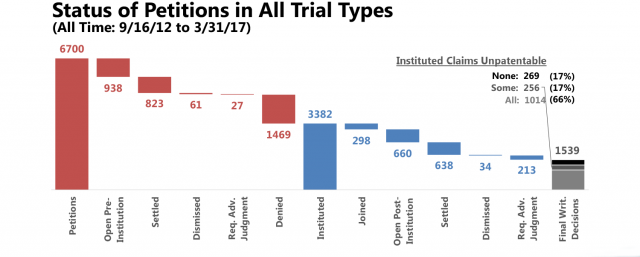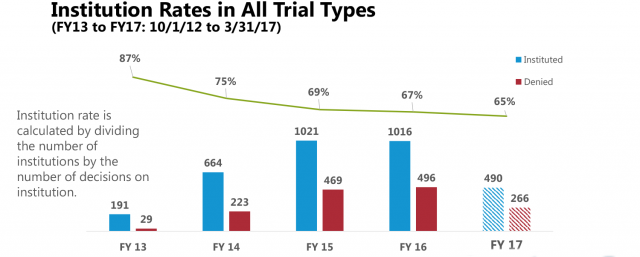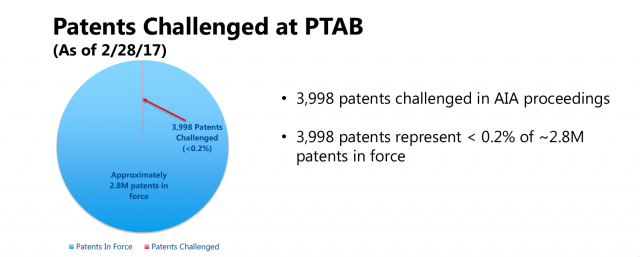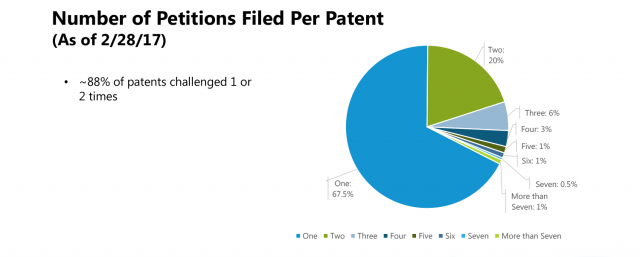Director of the USPTO Michelle K. Lee
May 16, 2017, 9:00 a.m.
2017 GW IP Law Symposium
Keynote Address by Director Michelle K. Lee
The George Washington University Law School
Lerner 401, 2000 H Street, NW, Washington, DC 20052
Thank you for the introduction, Dean Whealan, and good morning, everyone. It’s a real honor and pleasure to be with you today at what looks to be a wonderful program. A little over a week ago, I had the honor of speaking not far from here, at the National Building Museum—where we held the 45th Annual National Inventors Hall of Fame Induction Ceremony. This ceremony, co-hosted by the USPTO and the National Inventors Hall of Fame, honors visionary men and women who have conceived, patented, and advanced the greatest technological achievements of our nation. Many of their inventions spawned not only new businesses but also new industries, creating something where nothing like it existed before. Inductees receive a medal and are featured in the National Inventors Hall of Fame museum at the USPTO. At this year’s event, we honored 15 inventors who collectively hold almost 550 patents. Some of their incredible innovations include: a device for sensing gas density, used in the Apollo moon missions; a content delivery network to improve the speed of the Internet; and lead-free solder for electronic devices. Thanks to that last innovation, by Iver Anderson, more than 50,000 tons of lead per year are no longer released into the environment. The impact of these inventors, and their work, is profound. And it’s an excellent reminder why the USPTO must continue to help incentivize the kinds of innovation that put Iver Anderson, and the rest of this year’s inductees, in our National Inventors Hall of Fame.
How do we continue to incentivize these incredible innovations? First, we must ensure that the USPTO issues, the highest quality patents as quickly and efficiently as possible. This means, at a minimum, continuing to bring down our backlog and pendency so that good ideas can be patented quickly. Which is why I am proud to report that we’ve reduced our backlog of unexamined patent applications by almost 30 percent from its peak in January 2009, despite a 32 percent increase in applications over this time period. Our so-called first action pendencies – that measure the time from filing an application to the time of obtaining an initial decision from the examiner— are down by 43 percent—from 28 months in 2011 to 16 months today. Our total pendencies – the time from filing an application to the time of obtaining a final office action, such as an allowance—are down by 26 percent—from 35 months in 2010 to 26 months today. Our backlog of ex parte appeals – that’s not AIA proceedings, but our internal appeal process to the Board after the examiner issues her decision – has also gone down. We have reduced our inventory of ex parte appeals by 45 percent from a high of about 26,000 in 2012 to about 15,000 today. And, we have reduced the average pendency for appeals by 30 percent from 28 months in 2016 to 19 months today. In short, our backlog and pendencies are now lower than they’ve been in more than a decade, and they will continue to go down. Simply stated, this means more inventors are obtaining more patents more quickly.
As to our finances, today, we are more financially secure than ever before, thanks to the America Invents Act, which gave us, among other things, the ability to set our fees. And working with Congress, we’ve been able to access all of the fees. This means that, unlike prior years, you and the agency now obtain the full benefit of all of the fees that you pay. Over the past several years, we have also prudently budgeted, by accurately estimating our fee collections. And we have managed your resources well, including setting aside funds for an operating reserve (as any well-run business does). In fact, we have managed the funds so well, that we have not had to raise fees for almost four and a half years. And when we do propose raises, as we are doing now, we keep the increases very modest. And we continue to offer steep discounts for small businesses and individual inventors ranging from 50 to 75 percent discounts on over 200 patent-related fees.
As to our workforce, we know that it is critical to our patent system that we recruit and retain the best and brightest employees with specific technical expertise. So I’m proud to report that we enjoy some of the highest rankings in the list of Best Places to Work in the Federal Government. We all know that an engaged and skilled workforce serves you better, so we continue to focus on employee engagement and training. As to our engagement with the public, we are more customer-service oriented, more collaborative, and more responsive to stakeholders than ever before. We constantly welcome—in fact, we solicit—feedback and input. And we have shown that we are willing to refine and improve as many times as needed. For example, we’ve provided applicants with more access to examiner interviews more than doubling the number of interview hours in just eight years. We’ve had more RFC’s, proposed rules, and public roundtables than ever before – including on such topics as our Enhanced Patent Quality Initiative, our 101 guidance, and our Patent Trial and Appeal Board proceedings. We’ve also brought a broader range of services to support American innovators where and when needed, including through four regional offices across the country, and through over a dozen IP attaches across the globe. For those of you who may not know, our attaches in China, the EU, India, Brazil, and other locations help U.S. innovators obtain and enforce IP rights outside the U.S., and also help advocate for improved IP laws outside the U.S.
Armed with greater finances, a shrinking backlog, an engaged workforce, and strong support from the public, the agency has engaged in an unprecedented effort to enhance patent quality. Examining patents quickly and efficiently is only part of the job. The public relies on us to issue quality patents. Today, we have about a dozen programs underway that we believe will meaningfully improve patent quality. These include programs for making sure we’re getting the most relevant prior art before our examiners as early as possible by making prior art cited in our PTAB proceedings available to examiners handling related applications, and transitioning all our examiners from the decades old, antiquated U.S. Patent Classification System to the updated, increasingly global Cooperative Patent Classification System. Developing best practices such as for enhancing the clarity of the record. And developing new and better ways to measure our progress. For example, with our Master Review Form, we are now processing twice as many reviews, and capturing data not only about the correctness of our actions, but also about the clarity of our actions. This helps us identify trends, and helps us pinpoint very specific areas for improvement and targeted training for our examiners. Finally, and, importantly, for the first time in 40 years, we are doing a comprehensive review of the amount of time our examiners need to do their work in light of the many recent changes within the patent system. We are already seeing measurable and statistically significant results in our patent quality efforts even in the short amount of time since we began the Enhanced Patent Quality Initiative. And you can look forward to more improvements in the future. In sum, the USPTO is operating well, and is issuing more, higher quality patents than ever. Because the agency is healthy and well-functioning, we are poised to successfully accomplish the important work ahead.
What work lies ahead? Our top priority today is to make sure the Patent Trial and Appeal Board’s AIA proceedings are as effective and as fair as possible--within our Congressional mandate. Now is the right time to examine and make any needed reforms to these proceedings, because we have five years of data and experience to guide us. Of course, when I first took the helm of the USPTO, the AIA trials were relatively new, less than two years old. Everyone, including the Board and the public, was just getting used to these proceedings and how to use them. Even in those early days, we kicked off a series of public listening tours on the AIA proceedings. The goal was to check-in with stakeholders and communities and get their feedback – what was working, what was not, and what could we do better. We visited eight cities around the country to meet directly with practitioners. Shortly thereafter, we implemented a series of “quick fixes” to respond immediately to what we learned.
We came out several months later with proposals for more substantive changes via proposed rules. Then, based upon input and feedback from all of you—we published final rules that included several important changes. They included allowing patent owners to include new testimonial evidence, such as an expert declaration, prior to institution, requiring a new certification requirement for practitioners before the PTAB, akin to the Rule 11 requirements in federal courts; and clarifying that, for patents that will expire during a proceeding, the Board will use the claim construction standard used by district courts.
That’s what we’ve done in the past. What are we doing today? We are continuing that progress, but, again, better informed with five years’ worth of more and better data and user experiences to guide us. Like many of you, I am a scientist and engineer. I believe that discussions, decision, and policies should be informed by and, in fact, driven by data, facts, and repeated observations—all of which are combined to identify persistent trends. Let’s take a look at where we are with the AIA trials and data today. We have shared regular updates on the number of cases and the results of those cases, but we want to break down the numbers even further so that everyone has the facts, as there have been many numbers cited – some of which are accurate, some of which are not.
This waterfall slide is our attempt to present even more data in a more accessible and transparent format. According to waterfall slide data, which shows the status of every petition filed since beginning of AIA, of those petitions that have reached some sort of final disposition (i.e., are not pending), about one third of all petitions are denied institution and do not go to trial; about one third of all petitions settle either before or after the decision to institute; and only about one third of all petitions ever reach final written decision. It is only at that point of reaching final written decision is it relevant to talk about the patentability or unpatentability of the claims of a patent. And, at that point, it is true that 66 percent of petitions will find all instituted claims of the patent unpatentable, 17 percent of petitions will find all instituted claims of the patent patentable, and an additional 17 percent will have mixed results (some instituted claims will be found to be patentable and some will be found to be unpatentable). So statements that "all" or 95 percent or even 80 percent of patents are found unpatentable are not supported by the data and do not account for prior disposition by settlement or by denial of institution.
Drilling down further on the institution rate, here is some helpful data from the years the AIA trials have been in effect. As you can see, the institution rate in our proceedings has been steadily declining from a high of 87 percent in the beginning, to about two thirds today. These are the numbers, and these are the facts. Now, our stakeholders have understandably asked how the rates of unpatentability in AIA proceedings, reflect on the quality of all of the other patents we’ve issued. It’s a fair question. I think it is one indicator of quality. But let’s put matters in context.
As you can see in this slide there are almost 2.8 million patents in force. Incredible. Of those 2.8 million about 4,000 patents have been challenged in AIA trials. This represents less than 0.2 percent of the patents currently in force. Additionally, of all the patents involved in litigation since the AIA trials commenced, third-party research indicates that a relatively small percentage, about 15 percent, are ever brought to the Board for review. Further, many challenges relate not to patent “quality” per se—that is the quality of the work performed by our examiners--but to the ability of litigants to obtain prior art that was never before the examiner because they simply have more time and more resources to find prior art in litigation versus prosecution and examination. And, keep in mind that just because the Board finds a claim unpatentable does not necessarily mean it was improperly issued at time of grant. We are all well-aware of the significant changes in patent law over the recent years including some major changes to such fundamental issues as patent eligible subject matter and obviousness. This is not to say that we cannot do more to improve quality during examination. We can, we are, and we will continue to do so through our Enhanced Patent Quality Initiative, one of the most comprehensive focuses on improving patent quality in recent years.
We are also conducting important studies on these proceedings and other issues within the agency. We engaged in a study of motions to amend that is proving very useful to our discussion of how to improve our amendment practices. For example, we learned that, since 2015, patent owners have filed approximately 50 motions to amend per year. The PTAB has denied these motions primarily because the substitute claims failed to meet one of the statutory conditions for patentability. In other words, if the substitute claims were presented to an examiner during prosecution, the examiner would have rejected the claims on 101, 102, 103, or 112 grounds. We are wrapping up a study of filings of multiple petitions against a single patent (more on that in a moment); and, we are engaged in a 101 study based on input received from several USPTO-hosted roundtables and recent proposals issued by a number of stakeholders on what is, and should be, the scope of patent eligible subject matter to best incentivize innovation. We plan to publish a report shortly summarizing our findings and discussing potential next steps. So stay tuned for that.
Regarding our study of filings of multiple petitions and having heard from a number of stakeholders concerned about multiple petitions filed against a single patent, I asked my team to study our now five-years' worth of data. This is what we found:
This slide shows the number of petitions filed per patent for all the patents challenged to date in an AIA trial. For 68 percent of the patents, there was only one petition filed. For 20 percent of the patents, there were two petitions filed. For 6 percent of the patents, three petitions. And it drops down quickly from there. In sum, the data shows that the large majority of patents are only challenged only one time in AIA trials. And a relatively small percentage are challenged more than two times. Although it is important to understand the overall numbers, we understand that multiple challenges to even a single patent are a serious concern to our patent holders. And even a single challenge simply to harass a patent owner is unacceptable. So let us know your thoughts on our data and the issue of multiple challenges to a patent. We welcome your input.
As I have said many times in the past, the USPTO is constantly looking for ways to make the AIA trials as effective and as fair as possible within our Congressional mandate. And we welcome your suggestions and ideas, the more specific, the better. To this end, we’ve set up a mailbox where you can submit your ideas at PTABProceduralReformInitiative@uspto.gov. This is an early opportunity to provide input. Your feedback here will help form the basis for our recommendations to the administration on next steps.
In fact, we have already heard from a number of you regarding a number of issues. As discussed:
1). Multiple petitions, and how best to curb abusive practices.
2). Whether to provide other opportunities to amend claims later in the proceedings when patent owners may have a better sense of where their claims stand,
3). Whether to reevaluate our claim construction standards in view of new data and experiences, and
4). How to best incorporate the findings and legal conclusions of prior proceedings at the USPTO, including examination and other post-grant proceedings, as well as, importantly, proceedings conducted in the federal courts.
5). What considerations should go into a decision to institute, for example, how can we better take into account considerations such as the interests of justice, economic factors, and hardship.
6). As to decisions to institute, whether there should be additional review of institution and termination decisions—and by whom.
7). When and how to permit parties to join proceedings.
8). When and under what circumstances might it be appropriate to extend the length of the proceedings beyond 12 months and what impact would extensions have on litigations before, not only the Board, but district courts. I am proud that our Board judges have worked so hard to meet the 12-month deadline, but I realize that there may be some cases that require additional time, perhaps due to hardship, the complexity of the case, or the need for additional briefing when a new issue arises late in the proceeding.
Also, in a constant effort to streamline the operations of our Board, I am working closely with the Board to revise its Standard Operating Procedures regarding identification and designation of precedential decisions. The Board had fewer than 80 judges before the AIA was passed, and is now more than three times that size. As you can imagine, the approval process for making a decision precedential that worked for a Board of 80 judges does not necessarily work so well with a Board of almost 300. So we are streamlining the way the Board identifies and designates opinions as precedential, with the goal of designating more opinions precedential. Why? Because doing so
1). Improves the consistency across panels of the Board, and
2). Provides greater notice to the public to help you make better informed decisions on how to manage your Board proceedings.
Keep in mind, too, that you can tell us what opinions you think should be made precedential, and we welcome your input in this regard as well. Feel free to email us at the address I mentioned earlier: PTABProceduralReformInitiative@uspto.gov. We are also looking to provide more information to the public on how these AIA trials operate so the public can be better informed and avoid misconceptions. For example, we will plan to explain in more detail (through FAQs on our website):
1). How judges are assigned to a panel
2). How related cases are identified and handled; and
3). How potential conflicts are identified and resolved. If you have questions, please ask us.
Finally, we are also proposing increases to our AIA trial fees. AIA trial fees were initially set before the proceedings were in place, based on projected costs. Now we have actual cost information to inform our fee-setting decisions going forward. By way of background, in fiscal years 2014-2016, the costs of AIA trials were fully covered by the associated fees collected. Specifically, in 2014, we collected more than actual costs. In 2015, we collected more than actual costs, but by a smaller margin. But in 2016, we collected less than actual costs. This resulted in the proceedings being fully funded by the associated fees. However, recognizing that this would not continue with the current pricing, we issued a proposal in late 2015 that would raise fees so that the costs for AIA trials would continue to be fully recovered in future years. We believe, as many of you do, that these proceedings should be self-funded. I commend our team for making thoughtful initial cost projections and for recommending revisions to ensure that these proceedings are fully self-funded. There is much to do on AIA proceedings, patent quality, and in many other areas, and I promise you that we are working diligently, with a sense of purpose, every day.
In closing, we all want what’s best for this country’s inventors, innovators and entrepreneurs. Because it is through their efforts that our country remains at the forefront – economically and globally. Simply stated—and I think President Trump and Secretary Ross would agree—we want the United States to out-innovate and out-perform our global competitors, producing new jobs and new technologies and new industries that benefit all Americans, including individual inventors and those in our small businesses and startups. Let’s not forget that the modest businesses and unknown inventors of today may become the largest and most well-known drivers of our economy tomorrow. To make that happen, Congress, the courts, the administration (especially the USPTO), and even all of you here today, must all work together to make sure the system envisioned by our Founding Fathers lives up to its purpose to promote innovation. You have the commitment of the entire USPTO team that we will play our part to ensure that we continue to incentivize the kind of innovations that make our lives better and safer, and that put men and women—like Mr. Iver Anderson with his lead-free solder—in the National Inventors Hall of Fame. Our future depends upon it. Thank you.
###





